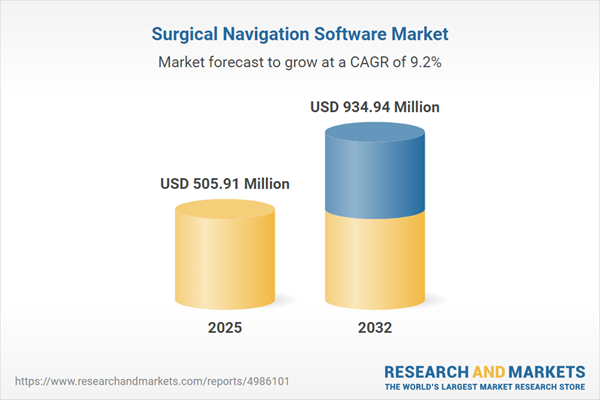Speak directly to the analyst to clarify any post sales queries you may have.
The surgical navigation software market is propelling healthcare organizations toward higher clinical accuracy and operational consistency. Senior decision-makers are turning to digital navigation solutions to support procedural precision, optimize patient outcomes, and advance long-term system reliability.
Surgical Navigation Software Market Snapshot
The surgical navigation software market is experiencing robust growth as hospitals and clinics worldwide adopt advanced guidance platforms. Real-time data integration and precision-guided navigation tools are reshaping operating room standards by driving reproducible surgical outcomes and supporting specialized clinical workflows. This momentum is strengthened by improved interoperability, allowing device manufacturers, technology partners, and research organizations to collaborate and elevate procedural reliability. The increasing implementation across diverse medical specialties and geographies signals a broader digital transformation within healthcare environments.
Scope & Segmentation of the Surgical Navigation Software Market
This report analyzes the critical forces shaping the global adoption of surgical navigation software and provides actionable insight for executive leadership overseeing technological transformation. Strategic segmentation covers the following dimensions:
- Technology Types: Electromagnetic tracking, optical navigation systems, and mechanical articulated arms are at the forefront of innovation, meeting a spectrum of surgical guidance requirements across a range of settings.
- Navigation Modes: 2D and 3D image-guided approaches offer flexibility, matching intervention complexity and the needs of varied clinical workflows.
- Application Areas: Software adoption spans multiple disciplines, equipping teams in dentistry, ENT, neurosurgery, oncology, orthopedics, and spinal surgery to address routine and complex clinical challenges.
- End User Settings: Adoption patterns diverge among community hospitals, academic medical centers, ambulatory surgical facilities, and specialty clinics, each group shaped by their unique performance imperatives and compliance requirements.
- Geographical Markets: The Americas, EMEA, and Asia-Pacific present notable opportunities and hurdles, with each region’s technology decision-making influenced by regulatory differences, evolving healthcare infrastructure, and shifting demographics.
- Key Industry Players: Leading companies include Medtronic plc, Brainlab AG, Stryker Corporation, Zimmer Biomet Holdings, Elekta AB, Intuitive Surgical, Johnson & Johnson, Siemens Healthineers, Globus Medical, and Stereotaxis, Inc., all driving development and flexible deployment.
Key Takeaways for Senior Decision-Makers
- Seamlessly integrating imaging, robotics, and navigation software elevates cross-specialty collaboration and supports broader organizational precision medicine strategies.
- Implementing augmented reality in minimally invasive surgery facilitates skills transfer and accelerates onboarding, increasing access to advanced procedures for multi-disciplinary teams.
- Unified, real-time clinical data delivered through software navigation platforms fosters transparency and enables prompt, evidence-based decision-making across surgical teams.
- Ergonomic interfaces and comprehensive clinical education programs accelerate digital adoption and uphold regulatory standards within care workflows.
- Partnerships between technology providers and device manufacturers enable adaptable deployment, sustaining operational flexibility amid changing clinical and regulatory demands.
Tariff Impact: Strategic and Supply Chain Considerations
Recent tariffs on U.S. surgical navigation system components are prompting provider organizations to reassess sourcing strategies and diversify their supplier base. This trend is bolstering supply chain resilience and reducing dependency on specific regions. Healthcare networks are increasingly turning to advanced analytics for supply chain risk planning, negotiating forward-looking contracts, and instituting contingency measures to mitigate exposure to regulatory and trade disruptions.
Research Methodology & Data Sources
The findings in this report are based on primary interviews with experienced surgeons, procurement professionals, and senior technology executives. The methodology incorporates regulatory reviews, recent peer-reviewed literature, and benchmarking data from industry competitors to deliver insight that is highly relevant to executive leadership in healthcare.
Why This Report Matters
- Aligns surgical navigation technology investments with evolving clinical, regulatory, and operational requirements, supporting sound, evidence-based decision-making for healthcare organizations.
- Delivers specific guidance for procurement, implementation, and scale-up strategies for digital navigation platforms across multiple care settings.
- Provides healthcare leadership with actionable, region-specific intelligence for optimizing efficiency, regulatory adherence, and care quality.
Conclusion
Surgical navigation software is enabling healthcare providers to achieve higher standards of care, adapt to regulatory changes, and realize operational enhancements. Executives who take an informed approach to its adoption are positioned to advance organizational goals within an increasingly digital healthcare sector.
Additional Product Information:
- Purchase of this report includes 1 year online access with quarterly updates.
- This report can be updated on request. Please contact our Customer Experience team using the Ask a Question widget on our website.
Table of Contents
3. Executive Summary
4. Market Overview
7. Cumulative Impact of Artificial Intelligence 2025
Companies Mentioned
The companies profiled in this Surgical Navigation Software market report include:- Medtronic plc
- Brainlab AG
- Stryker Corporation
- Zimmer Biomet Holdings, Inc.
- Elekta AB
- Intuitive Surgical, Inc.
- Johnson & Johnson
- Siemens Healthineers AG
- Globus Medical, Inc.
- Stereotaxis, Inc.
Table Information
| Report Attribute | Details |
|---|---|
| No. of Pages | 190 |
| Published | October 2025 |
| Forecast Period | 2025 - 2032 |
| Estimated Market Value ( USD | $ 505.91 Million |
| Forecasted Market Value ( USD | $ 934.94 Million |
| Compound Annual Growth Rate | 9.1% |
| Regions Covered | Global |
| No. of Companies Mentioned | 11 |









